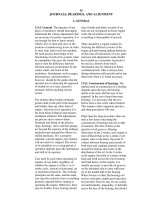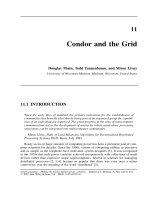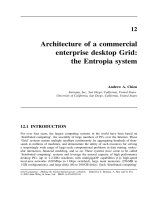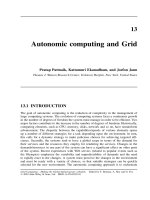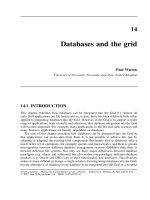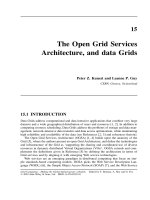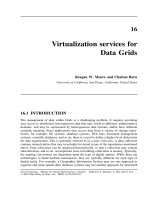Tài liệu Grid Computing P11 pptx
Bạn đang xem bản rút gọn của tài liệu. Xem và tải ngay bản đầy đủ của tài liệu tại đây (390.64 KB, 37 trang )
11
Condor and the Grid
Douglas Thain, Todd Tannenbaum, and Miron Livny
University of Wisconsin-Madison, Madison, Wisconsin, United States
11.1 INTRODUCTION
Since the early days of mankind the primary motivation for the establishment of
communities has been the idea that by being part of an organized group the capabil-
ities of an individual are improved. The great progress in the area of intercomputer
communication led to the development of means by which stand-alone processing
subsystems can be integrated into multicomputer communities.
– Miron Livny, Study of Load Balancing Algorithms for Decentralized Distributed
Processing Systems, Ph.D. thesis, July 1983.
Ready access to large amounts of computing power has been a persistent goal of com-
puter scientists for decades. Since the 1960s, visions of computing utilities as pervasive
and as simple as the telephone have motivated system designers [1]. It was recognized
in the 1970s that such power could be achieved inexpensively with collections of small
devices rather than expensive single supercomputers. Interest in schemes for managing
distributed processors [2, 3, 4] became so popular that there was even once a minor
controversy over the meaning of the word ‘distributed’ [5].
Grid Computing – Making the Global Infrastructure a Reality. Edited by F. Berman, A. Hey and G. Fox
2003 John Wiley & Sons, Ltd ISBN: 0-470-85319-0
300
DOUGLAS THAIN, TODD TANNENBAUM, AND MIRON LIVNY
As this early work made it clear that distributed computing was feasible, theoretical
researchers began to notice that distributed computing would be difficult. When messages
may be lost, corrupted, or delayed, precise algorithms must be used in order to build
an understandable (if not controllable) system [6, 7, 8, 9]. Such lessons were not lost
on the system designers of the early 1980s. Production systems such as Locus [10] and
Grapevine [11] recognized the fundamental tension between consistency and availability
in the face of failures.
In this environment, the Condor project was born. At the University of Wisconsin,
Miron Livny combined his 1983 doctoral thesis on cooperative processing [12] with the
powerful Crystal Multicomputer [13] designed by DeWitt, Finkel, and Solomon and the
novel Remote UNIX [14] software designed by Litzkow. The result was Condor, a new
system for distributed computing. In contrast to the dominant centralized control model
of the day, Condor was unique in its insistence that every participant in the system remain
free to contribute as much or as little as it cared to.
Modern processing environments that consist of large collections of workstations
interconnected by high capacity network raise the following challenging question:
can we satisfy the needs of users who need extra capacity without lowering the quality
of service experienced by the owners of under utilized workstations?
...
The Condor
scheduling system is our answer to this question.
– Michael Litzkow, Miron Livny, and Matt Mutka, Condor: A Hunter of Idle Work-
stations, IEEE 8th Intl. Conf. on Dist. Comp. Sys., June 1988.
The Condor system soon became a staple of the production-computing environment
at the University of Wisconsin, partially because of its concern for protecting individ-
ual interests [15]. A production setting can be both a curse and a blessing: The Condor
project learned hard lessons as it gained real users. It was soon discovered that inconve-
nienced machine owners would quickly withdraw from the community, so it was decreed
that owners must maintain control of their machines at any cost. A fixed schema for
representing users and machines was in constant change and so led to the development
of a schema-free resource allocation language called ClassAds [16, 17, 18]. It has been
observed [19] that most complex systems struggle through an adolescence of five to seven
years. Condor was no exception.
The most critical support task is responding to those owners of machines who feel
that Condor is in some way interfering with their own use of their machine. Such
complaints must be answered both promptly and diplomatically. Workstation owners
are not used to the concept of somebody else using their machine while they are
away and are in general suspicious of any new software installed on their system.
– Michael Litzkow and Miron Livny, Experience With The Condor Distributed
Batch System, IEEE Workshop on Experimental Dist. Sys., October 1990.
The 1990s saw tremendous growth in the field of distributed computing. Scientific
interests began to recognize that coupled commodity machines were significantly less
CONDOR AND THE GRID
301
expensive than supercomputers of equivalent power [20]. A wide variety of powerful
batch execution systems such as LoadLeveler [21] (a descendant of Condor), LSF [22],
Maui [23], NQE [24], and PBS [25] spread throughout academia and business. Several
high-profile distributed computing efforts such as SETI@Home and Napster raised the
public consciousness about the power of distributed computing, generating not a little
moral and legal controversy along the way [26, 27]. A vision called grid computing
began to build the case for resource sharing across organizational boundaries [28].
Throughout this period, the Condor project immersed itself in the problems of pro-
duction users. As new programming environments such as PVM [29], MPI [30], and
Java [31] became popular, the project added system support and contributed to standards
development. As scientists grouped themselves into international computing efforts such
as the Grid Physics Network [32] and the Particle Physics Data Grid (PPDG) [33], the
Condor project took part from initial design to end-user support. As new protocols such
as Grid Resource Access and Management (GRAM) [34], Grid Security Infrastructure
(GSI) [35], and GridFTP [36] developed, the project applied them to production systems
and suggested changes based on the experience. Through the years, the Condor project
adapted computing structures to fit changing human communities.
Many previous publications about Condor have described in fine detail the features of
the system. In this chapter, we will lay out a broad history of the Condor project and its
design philosophy. We will describe how this philosophy has led to an organic growth of
computing communities and discuss the planning and the scheduling techniques needed in
such an uncontrolled system. Our insistence on dividing responsibility has led to a unique
model of cooperative computing called split execution. We will conclude by describing
how real users have put Condor to work.
11.2 THE PHILOSOPHY OF FLEXIBILITY
As distributed systems scale to ever-larger sizes, they become more and more difficult to
control or even to describe. International distributed systems are heterogeneous in every
way: they are composed of many types and brands of hardware, they run various oper-
ating systems and applications, they are connected by unreliable networks, they change
configuration constantly as old components become obsolete and new components are
powered on. Most importantly, they have many owners, each with private policies and
requirements that control their participation in the community.
Flexibility is the key to surviving in such a hostile environment. Five admonitions
outline our philosophy of flexibility.
Let communities grow naturally: Humanity has a natural desire to work together on
common problems. Given tools of sufficient power, people will organize the comput-
ing structures that they need. However, human relationships are complex. People invest
their time and resources into many communities with varying degrees. Trust is rarely
complete or symmetric. Communities and contracts are never formalized with the same
level of precision as computer code. Relationships and requirements change over time.
Thus, we aim to build structures that permit but do not require cooperation. Relationships,
obligations, and schemata will develop according to user necessity.
302
DOUGLAS THAIN, TODD TANNENBAUM, AND MIRON LIVNY
Plan without being picky: Progress requires optimism. In a community of sufficient size,
there will always be idle resources available to do work. But, there will also always be
resources that are slow, misconfigured, disconnected, or broken. An overdependence on
the correct operation of any remote device is a recipe for disaster. As we design software,
we must spend more time contemplating the consequences of failure than the potential
benefits of success. When failures come our way, we must be prepared to retry or reassign
work as the situation permits.
Leave the owner in control : To attract the maximum number of participants in a com-
munity, the barriers to participation must be low. Users will not donate their property to
the common good unless they maintain some control over how it is used. Therefore, we
must be careful to provide tools for the owner of a resource to set use policies and even
instantly retract it for private use.
Lend and borrow: The Condor project has developed a large body of expertise in dis-
tributed resource management. Countless other practitioners in the field are experts in
related fields such as networking, databases, programming languages, and security. The
Condor project aims to give the research community the benefits of our expertise while
accepting and integrating knowledge and software from other sources.
Understand previous research: We must always be vigilant to understand and apply pre-
vious research in computer science. Our field has developed over many decades and is
known by many overlapping names such as operating systems, distributed computing,
metacomputing, peer-to-peer computing, and grid computing. Each of these emphasizes
a particular aspect of the discipline, but is united by fundamental concepts. If we fail to
understand and apply previous research, we will at best rediscover well-charted shores.
At worst, we will wreck ourselves on well-charted rocks.
11.3 THE CONDOR PROJECT TODAY
At present, the Condor project consists of over 30 faculties, full time staff, graduate and
undergraduate students working at the University of Wisconsin-Madison. Together the
group has over a century of experience in distributed computing concepts and practices,
systems programming and design, and software engineering.
Condor is a multifaceted project engaged in five primary activities.
Research in distributed computing: Our research focus areas and the tools we have pro-
duced, several of which will be explored below and are as follows:
1. Harnessing the power of opportunistic and dedicated resources. (Condor)
2. Job management services for grid applications. (Condor-G, DaPSched)
CONDOR AND THE GRID
303
3. Fabric management services for grid resources. (Condor, Glide-In, NeST)
4. Resource discovery, monitoring, and management. (ClassAds, Hawkeye)
5. Problem-solving environments. (MW, DAGMan)
6. Distributed I/O technology. (Bypass, PFS, Kangaroo, NeST)
Participation in the scientific community: Condor participates in national and interna-
tional grid research, development, and deployment efforts. The actual development and
deployment activities of the Condor project are a critical ingredient toward its success.
Condor is actively involved in efforts such as the Grid Physics Network (GriPhyN) [32],
the International Virtual Data Grid Laboratory (iVDGL) [37], the Particle Physics Data
Grid (PPDG) [33], the NSF Middleware Initiative (NMI) [38], the TeraGrid [39], and the
NASA Information Power Grid (IPG) [40]. Further, Condor is a founding member in
the National Computational Science Alliance (NCSA) [41] and a close collaborator of
the Globus project [42].
Engineering of complex software: Although a research project, Condor has a significant
software production component. Our software is routinely used in mission-critical settings
by industry, government, and academia. As a result, a portion of the project resembles
a software company. Condor is built every day on multiple platforms, and an automated
regression test suite containing over 200 tests stresses the current release candidate each
night. The project’s code base itself contains nearly a half-million lines, and significant
pieces are closely tied to the underlying operating system. Two versions of the software, a
stable version and a development version, are simultaneously developed in a multiplatform
(Unix and Windows) environment. Within a given stable version, only bug fixes to the
code base are permitted – new functionality must first mature and prove itself within
the development series. Our release procedure makes use of multiple test beds. Early
development releases run on test pools consisting of about a dozen machines; later in
the development cycle, release candidates run on the production UW-Madison pool with
over 1000 machines and dozens of real users. Final release candidates are installed at
collaborator sites and carefully monitored. The goal is that each stable version release
of Condor should be proven to operate in the field before being made available to the
public.
Maintenance of production environments: The Condor project is also responsible for the
Condor installation in the Computer Science Department at the University of Wisconsin-
Madison, which consist of over 1000 CPUs. This installation is also a major compute
resource for the Alliance Partners for Advanced Computational Servers (PACS) [43]. As
such, it delivers compute cycles to scientists across the nation who have been granted
computational resources by the National Science Foundation. In addition, the project
provides consulting and support for other Condor installations at the University and around
the world. Best effort support from the Condor software developers is available at no
charge via ticket-tracked e-mail. Institutions using Condor can also opt for contracted
304
DOUGLAS THAIN, TODD TANNENBAUM, AND MIRON LIVNY
support – for a fee, the Condor project will provide priority e-mail and telephone support
with guaranteed turnaround times.
Education of students: Last but not the least, the Condor project trains students to become
computer scientists. Part of this education is immersion in a production system. Students
graduate with the rare experience of having nurtured software from the chalkboard all
the way to the end user. In addition, students participate in the academic community
by designing, performing, writing, and presenting original research. At the time of this
writing, the project employs 20 graduate students including 7 Ph.D. candidates.
11.3.1 The Condor software: Condor and Condor-G
When most people hear the word ‘Condor’, they do not think of the research group and all
of its surrounding activities. Instead, usually what comes to mind is strictly the software
produced by the Condor project: the Condor High Throughput Computing System,often
referred to simply as Condor.
11.3.1.1 Condor: a system for high-throughput computing
Condor is a specialized job and resource management system (RMS) [44] for compute-
intensive jobs. Like other full-featured systems, Condor provides a job management
mechanism, scheduling policy, priority scheme, resource monitoring, and resource man-
agement [45, 46]. Users submit their jobs to Condor, and Condor subsequently chooses
when and where to run them based upon a policy, monitors their progress, and ultimately
informs the user upon completion.
While providing functionality similar to that of a more traditional batch queueing
system, Condor’s novel architecture and unique mechanisms allow it to perform well
in environments in which a traditional RMS is weak – areas such as sustained high-
throughput computing and opportunistic computing. The goal of a high-throughput com-
puting environment [47] is to provide large amounts of fault-tolerant computational power
over prolonged periods of time by effectively utilizing all resources available to the net-
work. The goal of opportunistic computing is the ability to utilize resources whenever they
are available, without requiring 100% availability. The two goals are naturally coupled.
High-throughput computing is most easily achieved through opportunistic means.
Some of the enabling mechanisms of Condor include the following:
•
ClassAds: The ClassAd mechanism in Condor provides an extremely flexible and
expressive framework for matching resource requests (e.g. jobs) with resource offers
(e.g. machines). ClassAds allow Condor to adopt to nearly any desired resource uti-
lization policy and to adopt a planning approach when incorporating Grid resources.
We will discuss this approach further in a section below.
•
Job checkpoint and migration: With certain types of jobs, Condor can transparently
record a checkpoint and subsequently resume the application from the checkpoint file.
A periodic checkpoint provides a form of fault tolerance and safeguards the accumu-
lated computation time of a job. A checkpoint also permits a job to migrate from
CONDOR AND THE GRID
305
one machine to another machine, enabling Condor to perform low-penalty preemptive-
resume scheduling [48].
•
Remote system calls: When running jobs on remote machines, Condor can often pre-
serve the local execution environment via remote system calls. Remote system calls is
one of Condor’s mobile sandbox mechanisms for redirecting all of a jobs I/O-related
system calls back to the machine that submitted the job. Therefore, users do not need to
make data files available on remote workstations before Condor executes their programs
there, even in the absence of a shared file system.
With these mechanisms, Condor can do more than effectively manage dedicated compute
clusters [45, 46]. Condor can also scavenge and manage wasted CPU power from oth-
erwise idle desktop workstations across an entire organization with minimal effort. For
example, Condor can be configured to run jobs on desktop workstations only when the
keyboard and CPU are idle. If a job is running on a workstation when the user returns
and hits a key, Condor can migrate the job to a different workstation and resume the
job right where it left off. Figure 11.1 shows the large amount of computing capacity
available from idle workstations.
Figure 11.1 The available capacity of the UW-Madison Condor pool in May 2001. Notice that a
significant fraction of the machines were available for batch use, even during the middle of the work
day. This figure was produced with CondorView, an interactive tool for visualizing Condor-managed
resources.
306
DOUGLAS THAIN, TODD TANNENBAUM, AND MIRON LIVNY
Moreover, these same mechanisms enable preemptive-resume scheduling of dedi-
cated compute cluster resources. This allows Condor to cleanly support priority-based
scheduling on clusters. When any node in a dedicated cluster is not scheduled to run
a job, Condor can utilize that node in an opportunistic manner – but when a schedule
reservation requires that node again in the future, Condor can preempt any opportunistic
computing job that may have been placed there in the meantime [30]. The end result is
that Condor is used to seamlessly combine all of an organization’s computational power
into one resource.
The first version of Condor was installed as a production system in the UW-Madison
Department of Computer Sciences in 1987 [14]. Today, in our department alone, Condor
manages more than 1000 desktop workstation and compute cluster CPUs. It has become
a critical tool for UW researchers. Hundreds of organizations in industry, government,
and academia are successfully using Condor to establish compute environments ranging
in size from a handful to thousands of workstations.
11.3.1.2 Condor-G: a computation management agent for Grid computing
Condor-G [49] represents the marriage of technologies from the Globus and the Condor
projects. From Globus [50] comes the use of protocols for secure interdomain commu-
nications and standardized access to a variety of remote batch systems. From Condor
comes the user concerns of job submission, job allocation, error recovery, and creation
of a friendly execution environment. The result is very beneficial for the end user, who
is now enabled to utilize large collections of resources that span across multiple domains
as if they all belonged to the personal domain of the user.
Condor technology can exist at both the frontends and backends of a middleware envi-
ronment, as depicted in Figure 11.2. Condor-G can be used as the reliable submission and
job management service for one or more sites, the Condor High Throughput Computing
system can be used as the fabric management service (a grid ‘generator’) for one or
{
{
{
Fabric
Grid
User
Application, problem solver, ...
Condor (Condor-G)
Globus toolkit
Condor
Processing, storage, communication, ...
Figure 11.2 Condor technologies in Grid middleware. Grid middleware consisting of technologies
from both Condor and Globus sit between the user’s environment and the actual fabric (resources).
CONDOR AND THE GRID
307
more sites, and finally Globus Toolkit services can be used as the bridge between them.
In fact, Figure 11.2 can serve as a simplified diagram for many emerging grids, such as
the USCMS Test bed Grid [51], established for the purpose of high-energy physics event
reconstruction.
Another example is the European Union DataGrid [52] project’s Grid Resource Broker,
which utilizes Condor-G as its job submission service [53].
11.4 A HISTORY OF COMPUTING COMMUNITIES
Over the history of the Condor project, the fundamental structure of the system has
remained constant while its power and functionality has steadily grown. The core com-
ponents, known as the kernel, are shown in Figure 11.3. In this section, we will examine
how a wide variety of computing communities may be constructed with small variations
to the kernel.
Briefly, the kernel works as follows: The user submits jobs to an agent.Theagent
is responsible for remembering jobs in persistent storage while finding resources will-
ing to run them. Agents and resources advertise themselves to a matchmaker,whichis
responsible for introducing potentially compatible agents and resources. Once introduced,
an agent is responsible for contacting a resource and verifying that the match is still
valid. To actually execute a job, each side must start a new process. At the agent, a
shadow is responsible for providing all of the details necessary to execute a job. At the
resource, a sandbox is responsible for creating a safe execution environment for the job
and protecting the resource from any mischief.
Let us begin by examining how agents, resources, and matchmakers come together to
form Condor pools. Later in this chapter, we will return to examine the other components
of the kernel.
The initial conception of Condor is shown in Figure 11.4. Agents and resources inde-
pendently report information about themselves to a well-known matchmaker, which then
Problem
solver
(DAGMan)
(Master−Worker)
User
Matchmaker
(central manager)
Agent
(schedd)
Shadow
(shadow)
Job
Resource
(startd)
Sandbox
(starter)
Figure 11.3 The Condor Kernel. This figure shows the major processes in a Condor system. The
common generic name for each process is given in large print. In parentheses are the technical
Condor-specific names used in some publications.
308
DOUGLAS THAIN, TODD TANNENBAUM, AND MIRON LIVNY
R
R
11
Condor
pool
3
2
M
R
A
Figure 11.4 A Condor pool ca. 1988. An agent (A) is shown executing a job on a resource
(R) with the help of a matchmaker (M). Step 1: The agent and the resource advertise themselves
to the matchmaker. Step 2: The matchmaker informs the two parties that they are potentially
compatible. Step 3: The agent contacts the resource and executes a job.
makes the same information available to the community. A single machine typically runs
both an agent and a resource daemon and is capable of submitting and executing jobs.
However, agents and resources are logically distinct. A single machine may run either or
both, reflecting the needs of its owner. Furthermore, a machine may run more than one
instance of an agent. Each user sharing a single machine could, for instance, run its own
personal agent. This functionality is enabled by the agent implementation, which does not
use any fixed IP port numbers or require any superuser privileges.
Each of the three parties – agents, resources, and matchmakers – are independent and
individually responsible for enforcing their owner’s policies. The agent enforces the sub-
mitting user’s policies on what resources are trusted and suitable for running jobs. The
resource enforces the machine owner’s policies on what users are to be trusted and ser-
viced. The matchmaker is responsible for enforcing community policies such as admission
control. It may choose to admit or reject participants entirely on the basis of their names
or addresses and may also set global limits such as the fraction of the pool allocable to
any one agent. Each participant is autonomous, but the community as a single entity is
defined by the common selection of a matchmaker.
As the Condor software developed, pools began to sprout up around the world. In the
original design, it was very easy to accomplish resource sharing in the context of one
community. A participant merely had to get in touch with a single matchmaker to consume
or provide resources. However, a user could only participate in one community: that
defined by a matchmaker. Users began to express their need to share across organizational
boundaries.
This observation led to the development of gateway flocking in 1994 [54]. At that
time, there were several hundred workstations at Wisconsin, while tens of workstations
were scattered across several organizations in Europe. Combining all of the machines
into one Condor pool was not a possibility because each organization wished to retain
existing community policies enforced by established matchmakers. Even at the University
of Wisconsin, researchers were unable to share resources between the separate engineering
and computer science pools.
The concept of gateway flocking is shown in Figure 11.5. Here, the structure of two
existing pools is preserved, while two gateway nodes pass information about participants
CONDOR AND THE GRID
309
R
R
R
G
R
R
A
Condor
Pool A
RG
Condor
Pool B
2
1
MM
3
1
3
4
Figure 11.5 Gateway flocking ca. 1994. An agent (A) is shown executing a job on a resource
(R) via a gateway (G). Step 1: The agent and resource advertise themselves locally. Step 2: The
gateway forwards the agent’s unsatisfied request to Condor Pool B. Step 3: The matchmaker informs
the two parties that they are potentially compatible. Step 4: The agent contacts the resource and
executes a job via the gateway.
between the two pools. If a gateway detects idle agents or resources in its home pool, it
passes them to its peer, which advertises them in the remote pool, subject to the admission
controls of the remote matchmaker. Gateway flocking is not necessarily bidirectional. A
gateway may be configured with entirely different policies for advertising and accepting
remote participants. Figure 11.6 shows the worldwide Condor flock in 1994.
The primary advantage of gateway flocking is that it is completely transparent to
participants. If the owners of each pool agree on policies for sharing load, then cross-pool
matches will be made without any modification by users. A very large system may be
grown incrementally with administration only required between adjacent pools.
There are also significant limitations to gateway flocking. Because each pool is rep-
resented by a single gateway machine, the accounting of use by individual remote users
Delft
Warsaw
Madison
200 3
3
30
Amsterdam
3
10
3
Geneva 10
4Dubna/Berlin
Figure 11.6 Worldwide Condor flock ca. 1994. This is a map of the worldwide Condor flock in
1994. Each dot indicates a complete Condor pool. Numbers indicate the size of each Condor pool.
Lines indicate flocking via gateways. Arrows indicate the direction that jobs may flow.
310
DOUGLAS THAIN, TODD TANNENBAUM, AND MIRON LIVNY
is essentially impossible. Most importantly, gateway flocking only allows sharing at the
organizational level – it does not permit an individual user to join multiple communities.
This became a significant limitation as distributed computing became a larger and larger
part of daily production work in scientific and commercial circles. Individual users might
be members of multiple communities and yet not have the power or need to establish a
formal relationship between both communities.
This problem was solved by direct flocking, shown in Figure 11.7. Here, an agent may
simply report itself to multiple matchmakers. Jobs need not be assigned to any individual
community, but may execute in either as resources become available. An agent may still
use either community according to its policy while all participants maintain autonomy as
before.
Both forms of flocking have their uses, and may even be applied at the same time.
Gateway flocking requires agreement at the organizational level, but provides immediate
and transparent benefit to all users. Direct flocking only requires agreement between one
individual and another organization, but accordingly only benefits the user who takes the
initiative.
This is a reasonable trade-off found in everyday life. Consider an agreement between
two airlines to cross-book each other’s flights. This may require years of negotiation,
pages of contracts, and complex compensation schemes to satisfy executives at a high
level. But, once put in place, customers have immediate access to twice as many flights
with no inconvenience. Conversely, an individual may take the initiative to seek ser-
vice from two competing airlines individually. This places an additional burden on the
customer to seek and use multiple services, but requires no Herculean administrative
agreement.
Although gateway flocking was of great use before the development of direct flocking,
it did not survive the evolution of Condor. In addition to the necessary administrative
complexity, it was also technically complex. The gateway participated in every interaction
in the Condor kernel. It had to appear as both an agent and a resource, communicate
with the matchmaker, and provide tunneling for the interaction between shadows and
sandboxes. Any change to the protocol between any two components required a change
R
R
R
R
R
A
Condor
Pool A
R
Condor
Pool B
M
11
33
2
4
M
Figure 11.7 Direct flocking ca. 1998. An agent (A) is shown executing a job on a resource (R) via
direct flocking. Step 1: The agent and the resource advertise themselves locally. Step 2: The agent
is unsatisfied, so it also advertises itself to Condor Pool B. Step 3: The matchmaker (M) informs
the two parties that they are potentially compatible. Step 4: The agent contacts the resource and
executes a job.
CONDOR AND THE GRID
311
to the gateway. Direct flocking, although less powerful, was much simpler to build and
much easier for users to understand and deploy.
About 1998, a vision of a worldwide computational Grid began to grow [28]. A signifi-
cant early piece in the Grid computing vision was a uniform interface for batch execution.
The Globus Project [50] designed the GRAM protocol [34] to fill this need. GRAM pro-
vides an abstraction for remote process queuing and execution with several powerful
features such as strong security and file transfer. The Globus Project provides a server
that speaks GRAM and converts its commands into a form understood by a variety of
batch systems.
To take advantage of GRAM, a user still needs a system that can remember what jobs
have been submitted, where they are, and what they are doing. If jobs should fail, the
system must analyze the failure and resubmit the job if necessary. To track large numbers
of jobs, users need queueing, prioritization, logging, and accounting. To provide this
service, the Condor project adapted a standard Condor agent to speak GRAM, yielding
a system called Condor-G, shown in Figure 11.8. This required some small changes to
GRAM such as adding durability and two-phase commit to prevent the loss or repetition
of jobs [55].
The power of GRAM is to expand the reach of a user to any sort of batch system,
whether it runs Condor or not. For example, the solution of the NUG30 [56] quadratic
assignment problem relied on the ability of Condor-G to mediate access to over a thousand
hosts spread across tens of batch systems on several continents. We will describe NUG30
in greater detail below.
The are also some disadvantages to GRAM. Primarily, it couples resource allocation
and job execution. Unlike direct flocking in Figure 11.7, the agent must direct a partic-
ular job, with its executable image and all, to a particular queue without knowing the
availability of resources behind that queue. This forces the agent to either oversubscribe
itself by submitting jobs to multiple queues at once or undersubscribe itself by submitting
jobs to potentially long queues. Another disadvantage is that Condor-G does not support
all of the varied features of each batch system underlying GRAM. Of course, this is a
necessity: if GRAM included all the bells and whistles of every underlying system, it
R
R
RRR
A
R
Foreign batch system Foreign batch system
11
2
2
Figure 11.8 Condor-G ca. 2000. An agent (A) is shown executing two jobs through foreign batch
queues (Q). Step 1: The agent transfers jobs directly to remote queues. Step 2: The jobs wait for
idle resources (R), and then execute on them.
312
DOUGLAS THAIN, TODD TANNENBAUM, AND MIRON LIVNY
Step one:
User submits Condor daemons
as batch jobs in foreign systems
Step two:
Submitted daemons form an
adhoc
personal Condor pool
User runs jobs on
personal Condor pool
Step three:
RRR RR
A
R
Foreign batch system Foreign batch system
RRR RR
A
R
Personal Condor pool
RRR RRR
Personal Condor pool
M
M
M
A
GRAM GRAM
Figure 11.9 Condor-G and Gliding In ca. 2001. A Condor-G agent (A) executes jobs on resources
(R) by gliding in through remote batch queues (Q). Step 1: A Condor-G agent submits the Condor
daemons to two foreign batch queues via GRAM. Step 2: The daemons form a personal Condor
pool with the user’s personal matchmaker (M). Step 3: The agent executes jobs as in Figure 11.4.
would be so complex as to be unusable. However, a variety of useful features, such as
the ability to checkpoint or extract the job’s exit code are missing.
This problem is solved with a technique called gliding in, shown in Figure 11.9. To
take advantage of both the powerful reach of Condor-G and the full Condor machinery,
a personal Condor pool may be carved out of remote resources. This requires three steps.
In the first step, a Condor-G agent is used to submit the standard Condor daemons as jobs
to remote batch systems. From the remote system’s perspective, the Condor daemons are
ordinary jobs with no special privileges. In the second step, the daemons begin executing
and contact a personal matchmaker started by the user. These remote resources along with
the user’s Condor-G agent and matchmaker form a personal Condor pool. In step three,



